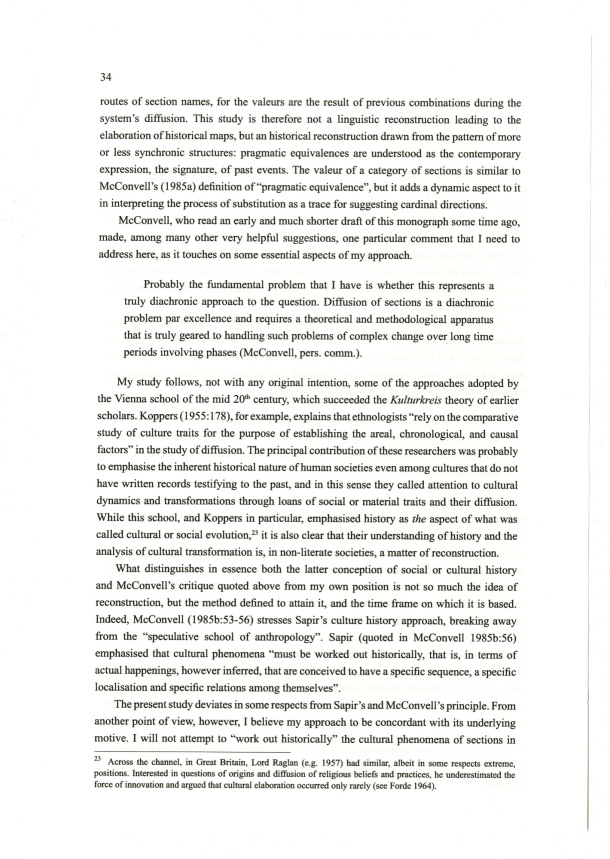|
| 
[Note: this transcription was produced by an automatic OCR engine]
34
routes of section names, for the valeurs are the result of previous combinations during the
system’s dilfusion. This study is therefore not a linguistic reconstruction leading to the
elaboration of historical maps, but an historical reconstruction drawn from the pattern of more
or less synchronic structures: pragmatic equivalences are understood as the contemporary
expression, the signature, of past events. The valeur of a category of sections is similar to
McConvell’s 1985a definition of “pragmatic equivalence”, but it adds a dynamic aspect to it
in interpreting the process of substitution as a trace for suggesting cardinal directions.
McConvell, who read an early and much shorter draft of this monograph some time ago,
made, among many other very helpful suggestions, one particular comment that I need to
address here, as it touches on some essential aspects of my approach.
Probably the fundamental problem that I have is whether this represents a
truly diachronic approach to the question. Diffusion of sections is a diachronic
problem par excellence and requires a theoretical and methodological apparatus
that is truly geared to handling such problems of complex change over long time
periods involving phases McConvell, pers. comm.
My study follows, not with any original intention, some of the approaches adopted by
the Vienna school of the mid 20"’ century, which succeeded the Kulturkreis theory of earlier
scholars. Koppers 1955: 1 78, for example, explains that ethnologists “rely on the comparative
study of culture traits for the purpose of establishing the areal, chronological, and causal
factors” in the study of diffirsion. The principal contribution of these researchers was probably
to emphasise the inherent historical nature of human societies even among cultures that do not
have written records testifying to the past, and in this sense they called attention to cultural
dynamics and transformations through loans of social or material traits and their diffusion.
While this school, and Koppers in particular, emphasised history as the aspect of what was
called cultural or social evolution,“ it is also clear that their understanding of history and the
analysis of cultural transformation is, in non-literate societies, a matter of reconstruction.
What distinguishes in essence both the latter conception of social or cultural history
and McConvell’s critique quoted above from my own position is not so much the idea of
reconstruction, but the method defined to attain it, and the time frame on which it is based.
Indeed, McConvell l985b:53-56 stresses Sapir’s culture history approach, breaking away
from the “speculative school of anthropology”. Sapir quoted in McConvell l985b:56
emphasised that cultural phenomena “must be worked out historically, that is, in terms of
actual happenings, however inferred, that are conceived to have a specific sequence, a specific
localisation and specific relations among themselves”.
The present study deviates in some respects from Sapir’s and McConvell’s principle. From
another point of view, however, I believe my approach to be concordant with its underlying
motive. I will not attempt to “work out historically” the cultural phenomena of sections in
13 Across the channel, in Great Britain, Lord Raglan eg. 1957 had similar, albeit in some respects extreme,
positions. Interested in questions of origins and ditfusion of religious beliefs and practices, he underestimated the
force of innovation and argued that cultural elaboration occurred only rarely see Forde 1964.
|